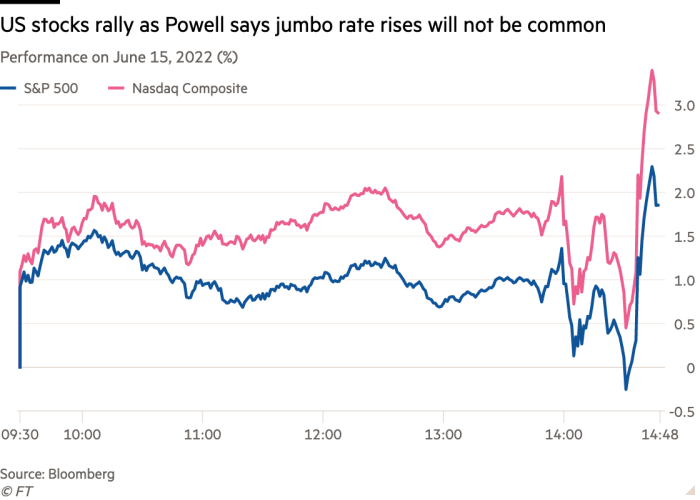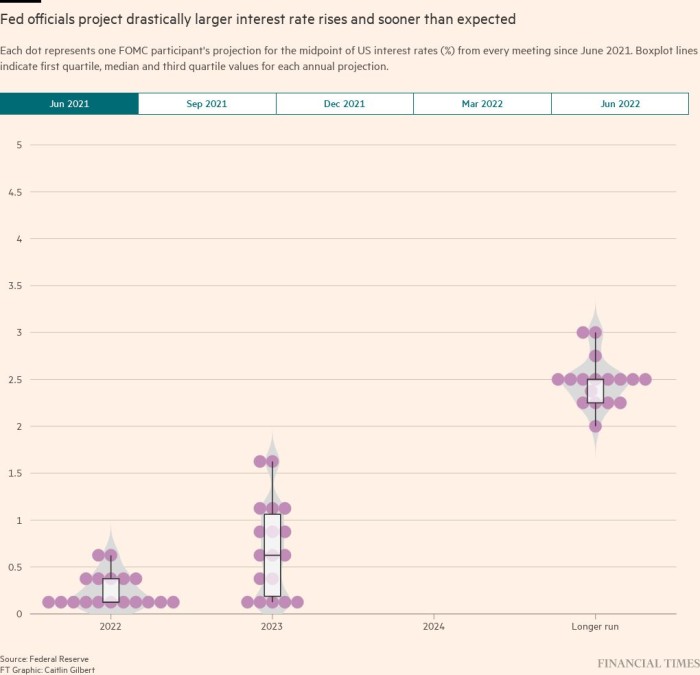The Federal Reserve raised its benchmark policy rate by 0.75 percentage points and said another adjustment of that size was possible at its next meeting, signalling an aggressive pace of monetary tightening in the coming months as the central bank tries to tame the highest US inflation in 40 years.
At the end of its two-day policy meeting, the Federal Open Market Committee on Wednesday lifted its benchmark policy rate to a new target range of 1.50 per cent to 1.75 per cent, noting in a statement that it “anticipates that ongoing increases in the target range will be appropriate”.
The decision marks an abrupt pivot from the Fed’s previously telegraphed plans for a second consecutive 0.50 percentage point rate rise, which had been explicitly signalled by policymakers before the start of a scheduled “blackout” period ahead of the meeting during which their public communications are limited.
Esther George, president of the central bank’s Kansas City branch, was the sole dissenter, and instead backed adhering to the Fed’s previous guidance.
The increase comes after two alarming reports released on Friday showed an unexpectedly large jump in consumer prices in May and a worrying rise in inflation expectations, suggesting that Americans are growing more concerned about the economic outlook.
Jay Powell, Fed chair, noted at a press conference after the decision that high inflation was a major factor in raising rates by 0.75 percentage points, the first increase of that size since 1994 — although he said he did not expect adjustments of that magnitude to become common. However, Powell said an increase of either 0.50 or 0.75 percentage points was likely at the central bank’s next meeting.
“The committee is highly attentive to inflation risks,” the Fed said in its statement, flagging that Russia’s invasion of Ukraine has created “additional upward pressure” on inflation and weighing on economic activity. It also added that extended lockdowns in China to combat Covid-19 surges are worsening supply chain disruptions that have helped to bid up prices.
Officials at the US central bank also on Wednesday sharply raised their rate forecasts compared to three months ago, when they had pencilled in the federal funds rate reaching 1.9 per cent by year end and 2.8 per cent in 2023.
The “dot plot” of individual interest rate projections now suggests the policy rate will rise to 3.4 per cent by the end of 2022 — a level that suggests the Fed could implement at least one more 0.75 percentage point increase this year and a couple half-point adjustments before moderating to a more typical quarter-point cadence.
Powell said that FOMC officials more broadly wanted to see rates at a “modestly restrictive level” by the end of the year.
Additional interest rate increases are also anticipated in 2023, with officials indicating the policy rate could reach 3.8 per cent. Notably, the median forecast for the federal funds rate in 2024 was 3.4 per cent, suggesting the Fed will need to reverse its ongoing rate rises in recognition of the fact that the economy is likely to have slowed considerably by that point.
Alongside the dot plot, the Fed published new economic projections that more directly indicate that the forthcoming monetary tightening — which also includes a scaling-back of the $9tn balance sheet — will involve “some pain”, as Powell acknowledged last month.
The Fed chair admitted Wednesday that the path to bringing down inflation without causing significant economic damage was “not getting easier”.
“The worst mistake we can make would be to fail, which is not an option,” Powell said. “We have to restore price stability.”
Annual growth in gross domestic product is now forecast to slow to 1.7 per cent by the end of this year and maintain that level in 2023, according to the median of top officials’ economic estimates. In March, they had predicted the economy would expand each year by 2 per cent or more through 2024.
Fed officials now expect core inflation to settle at 4.3 per cent this year and 2.7 per cent in 2023, slightly higher than what was forecast in March. Reflecting the impact of tightening policy, the unemployment rate is forecast to rise more substantially than the 3.5 per cent level officials in March had pencilled in through the end of next year. It is now set to reach 3.9 per cent in 2023 and 4.1 per cent in 2024. It currently stands at 3.6 per cent.

The Fed is not alone in its efforts to tackle inflation, which has become a global phenomenon. Central banks across advanced and emerging economies have been rapidly raising interest rates in short order, with plans to do more this year.
The European Central Bank has since been forced to fine tune its policy, however. It convened an emergency meeting of its rate-setters on Wednesday where it announced new emergency measures to tackle surging borrowing costs in weaker eurozone economies.
US financial markets rallied after Powell said that he expected a 0.75 percentage point tightening to be relatively uncommon, putting both a 0.5 and 0.75 percentage point increase in the federal funds rate on the table at the central bank’s next policy meeting.
The benchmark S&P 500 rallied 1.4 per cent, rebounding from its worst five-day rout since the early days of the coronavirus pandemic. The tech-heavy Nasdaq Composite surged 2.4 per cent.
The $23tn US Treasury market also strengthened on Powell’s comments, with the yield on the 10-year note — which sets borrowing costs across the globe — falling 0.09 percentage points to 3.38 per cent. Yields fall when bond prices rise.
“There was a hawkish risk that the market would take 75 basis points and price it in to multiple consecutive meetings,” said Ben Jeffery, a strategist at BMO Capital Markets. “The fact Powell came out against that idea was read as risk on.”
https://news.google.com/__i/rss/rd/articles/CBMiP2h0dHBzOi8vd3d3LmZ0LmNvbS9jb250ZW50LzRlZTI3NmNmLThhNWQtNGFlYS04OGJjLTBjN2MzNGJmOTZmY9IBAA?oc=5
2022-06-15 18:54:42Z
1464305846

Tidak ada komentar:
Posting Komentar